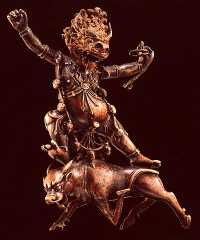
Dr. C. George Boeree
Shippensburg University

The following sections explain some of the concepts and ideas in Buddhism that are taken by most Buddhists as metaphorical or even plain mythological. Nevertheless, these things show up even in the most sophisticated texts, and so the student of Buddhism should be familiar with them -- even if they seem at times to take away rather than contribute to the deeper meaning of the Dharma. Westerners are often less comfortable with these things than are easterners, who have grown up with these terms. But a little thought and the reader will recognize that we have very similar concepts in the west, which we use in a similar fashion: Heavens and hells, ghosts and angels, the trinity, the saints.... Whether we take them literally or not, they are a part of how we tell our stories.
The Buddhists, following the traditions of their Indian fore-fathers, saw the universe as infinite in time and space, and filled with an infinite number of worlds like our own.
Above our ordinary world, there are two realms: the realm of
form
(rupa-dhatu) and the even higher realm of formlessness (arupa-dhatu).
Below these is the realm of desire (kama-dhatu) which contains
six
domains (gatis), each with its own kinds of beings:

All of the above, even the realms of form and formlessness, are in samsara , imperfect existence, and therefore governed by karma and its fruits (vipaka).
The world extends around Mount Meru. Above the peak is the realm of the Buddha fields (or heavens). On the upper slopes you find the gods. The titans live on the lower slopes. Animals and humans live on the plains around the mountain. Hungry ghosts live on or just below the surface. And hell is deep under the earth. All this is surrounded by a great ocean.
Time in Buddhist cosmology is measured in kalpas. Originally, a kalpa was considered to be 4,320,000 years. Buddhist scholars expanded it with a metaphor: rub a one-mile cube of rock once every hundred years with a piece of silk, until the rock is worn away -- and a kalpa still hasn’t passed! During a kalpa, the world comes into being, exists, is destroyed, and a period of emptiness ensues. Then it all starts again.
Some of the actors in the Buddhist mythological drama include...
Brahma -- the supreme deva, who
convinced Buddha to teach.
Indra -- a major deva, originally the Hindu sky god.
Prajña -- goddess of knowledge. Buddha’s mother
was considered an incarnation.
Mara -- a deva associated with death and hindrances to
enlightenment.
It was Mara who tempted Buddha under the bodhi tree.
Yama -- the king of the 21 hells (see image above).
Nagas -- great serpents (or dragons, or water creatures). The
king of the Nagas protected Buddha from a storm.
Gandharvas -- angelic beings who provide the gods with music
Trikaya
In Mahayana and especially Vajrayana, the idea of the Buddha and his Dharma evolved into a more elaborate system called the Trikaya, or three bodies of Buddha:
1. Nirmanakaya -- The earthly Buddhas (and Bodhisattvas), especially as personified by Siddhartha Gautama. In Tibet, the intentional human embodiment of a reborn master.
2. Sambhogakaya -- Buddhas in their heavens, the result of accumulated merit. Or, in Zen, enlightenment. In Tibetan buddhism, this refers to the means of achieving the Dharmakaya, i.e. the power of meditation on the various visualized dieties called yidams which are archetypal symbols of different qualities of enlightenment.
3. Dharmakaya -- The teachings of the Buddha, and the true nature of the Buddha, which is everything. Buddha mind, or Shunyata.
In Tibet, they also refer to the body, speech, and mind of a master. And they are represented by the mudra, the mantra, and the mandala, respectively.
Buddha Families
Transcendent (or Dhyani) Buddhas
These symbolize aspects of enlightened consciousness:
1. Vairochana -- center, white, tathagata family, ignorance and wisdom, the primordial Buddha.
2. Akshobhya -- east, blue, vajra (diamond) family, aggression and mirrorlike wisdom.
3. Ratnasambhava -- south, yellow, ratna (jewel) family, pride and equanimity.
4. Amitabha1 -- west, red, padma (lotus) family, passion and discriminating awareness, governs the present age.
Bodhisattvas and Buddhas
Corresponding to these five transcendent Buddhas, there are five
Bodhisattvas
and five earthly Buddhas:
| 1. Samantabhadra | Krakucchanda |
| 2. Vajrapani | Kanakamuni |
| 3. Ratnapani | Kashyapa |
| 4. Avalokiteshvara (Kuan Yin)2 | Shakyamuni (Siddhartha Gotama) |
| 5. Vishvapani | Maitreya (the future Buddha)3 |

2 Avalokiteshwara (Chenrezi, Kwan Yin, Kwannon) is the boddhisattva of compassion. Avalokiteshwara is often represented by a female figure, or an ambiguous one, in the Mahayana tradition. (See image at right)
The Taras are a set of 21 female saviors, born from Avalokiteshwara’s tears. Green Tara and White Tara are the best known.
3 Maitreya is the future Buddha, who will be born 30,000 years from now. The Chinese monk called Pu-tai (Ho-tei in Japanese) -- “the laughing buddha” -- is considered a pre-incarnation of Maitreya.
Snelling, John (1991). The Buddhist Handbook. Rochester, VT: Inner Traditions.
Rahula, Walpola (1959). What the Buddha Taught. NY: Grove Press.
Gard, Richard (1962). Buddhism. NY: George Braziller.
The Encyclopedia of Eastern Philosophy and Religion (1994). Boston: Shambhala.
The Encyclopaedia Britannica CD (1998). Chicago: Encyclopaedia Britannica.
Return to Top
Return to
Table of Contents
Return to Homepage